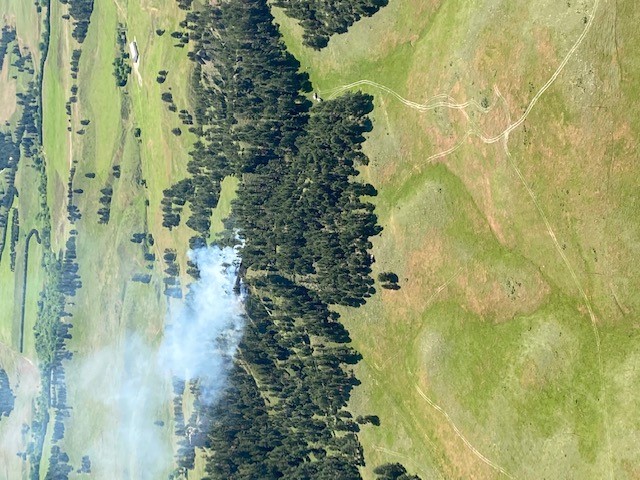Observation Flights Find Fires Fast
RELEASE DATE: Jun 16, 2021
Civil Air Patrol Assists Local Fire Departments in Early Detection of Wildfires
Fire season has arrived for the year in Nebraska and local fire chiefs have begun requesting observation flights to detect possible wildfires as soon after lightning strikes as possible.
The Nebraska Emergency Management Agency (NEMA), the Nebraska Forest Service (NFS) and the Civil Air Patrol (CAP) have a long history of working together in various capacities to prevent and extinguish wildfires.
Last Friday, at the request of local volunteer fire department chiefs, a detection flight discovered three fires in addition to three working fires. The flight crew was able to report the fires to crews on the ground.
“These flights are one of the tools we have to put out fires before they get out of hand,” said NEMA Assistant Director Bryan Tuma. “The CAP aircraft and pilots are prepared to respond rapidly when local fire departments need aerial fire detection flights during fire weather and drought conditions. These flights are essential in our efforts to reduce the destruction that can be caused by wildfires.”
NEMA, NFS and CAP have a memorandum of understanding to accomplish fire detection missions statewide. The volunteer CAP pilots and observers fly predetermined routes, after lightning storms, to detect possible fire starts, Tuma said. CAP can fly as low as 1,000 feet above ground level, which is beneficial in detecting a fire. The pilot and observers can get GPS readings, orbit a fire and then make contact with volunteer fire departments and state or federal resources on pre-established air-to-ground frequencies to report on active fires.
Fire chiefs in Valentine, Chadron and Crawford requested flights Monday and Seth Peterson, a fire management specialist with NFS served as the observer for the flight as well as those over the weekend.
“We didn’t spot any fires on Monday or Saturday,” Peterson said, “but last Friday was a different matter. We located three areas of smoke and provided access routes we could see from the air. We got ground crews to them quickly. Local firefighters were able to knock them down and prevent them from escalating.”
Peterson said before the flight, the crew has access to a lightening map that details lightning strikes during thunderstorms. This gives them a look at the activity of the storm and helps them to know where there is potential for a fire start.
“We are looking for smoke in the area of ground strikes,” Peterson said. “We stay in radio contact with ground crews so they can respond immediately to any smoking areas we detect. While we were in the area Monday Crawford’s Volunteer Fire Department had trucks spread out throughout the district to rapidly respond. The aircrew stays in the area until released by the incident commander.”
The requested missions are reimbursed by NEMA according to NEMA Preparedness and Operations Administrator Sean Runge.
“In the Pine Ridge of northwest Nebraska, there are areas that can’t be seen from the ground,” Runge said. “These flights are our best defense against large fires,” Runge said. “We definitely appreciate the resources the Civil Air Patrol brings to our efforts to reduce the size and scope of wildfires in Nebraska.”
In addition to the resources of CAP, the Single Engine Air Tanker (SEAT) program and the volunteer fire departments across the state work to keeps fires small, Runge said. These efforts can save rural grassland, eastern red cedar and Ponderosa pine forest resources that could eventually disappear or be altered due to the severity of wildland fires.
The NFS publishes the Emergency Assistance for Wildfire Control or Yellowbook in cooperation with NEMA as a description of aviation suppression resources available to the rural fire districts and fire departments in Nebraska. This quick reference for available statewide resources includes information on who to contact for resources including state, federal and private agencies as well as aerial applicators, foam retardant suppliers and deployment procedures for ordering a SEAT
NEMA and NFS jointly contract the SEAT and manage its deployment to Nebraska during fire season in an effort to provide rapid, efficient support for active wildfire incidents. Local incident commanders can request deployment through the Great Plains Dispatch Center.
The State of Nebraska is also part of the Great Plains Interstate Wildfire Compact that includes the states of Colorado, Kansas, Nebraska, New Mexico, North Dakota and Wyoming and the Province of Saskatchewan in Canada. The compact promotes effective prevention and control of wildfires and allows resource sharing system to assist partner states and provinces in wildfire management activities.
“A prime example of this was the Hubbard Gap Fire in Banner County during August 2020, Tuma said. “Through the compact, South Dakota provided air support to our efforts to get the fire under control. It takes a team effort to fight a fire of that size and in addition to the assistance from South Dakota, local firefighters, the State Fire Marshal and NFS Wildland Incident Response Assistance Team, the SEAT and Nebraska National Guard helicopters worked together to put that fire to rest.”
.jpg)

